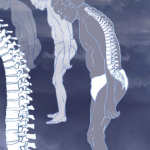If approved by the U.S. Food and Drug Administration (FDA), difficult-to-treat patients with axial spondyloarthritis who fail or are intolerant to standard treatment with tumor necrosis factor inhibitors (TNFi) may have a new treatment option.
That new option is a high-affinity monoclonal antibody, called ixekizumab, which selectively targets an area linked to the immunopathology of axial spondyloarthritis—specifically, the interleukin (IL) 17 axis. Prior studies have shown the efficacy of IL-17 inhibition in patients with axial spondyloarthritis. Secukinumab is the first agent in this class to show efficacy in treating patients with this condition.1-3 Most of the secukinumab trials enrolled patients who were exclusively or predominantly disease-modifying anti-rheumatic drug (DMARD) naive. Lacking, however, are data evaluating the efficacy of IL-17 inhibition specifically in patients who fail to respond adequately to, or are intolerant of, TNF inhibitors.
A new study looked at the efficacy and safety of ixekizumab in this setting.
“Ankylosing spondylitis is a chronic and debilitating disease, and I have a large number of patients who have failed TNF inhibitors,” says lead author of the study Atul Deodhar, MD, a professor of medicine and the medical director of the Rheumatology Clinics in the Division of Arthritis & Rheumatic Diseases at the Oregon Health & Science University in Portland. “There’s a need for more options specifically for difficult-to-treat patient populations. This research provides valuable insights into the potential for ixekizumab to become a new treatment option for patients with ankylosing spondylitis,” he says.
Focus on Difficult-to-Treat Patients

Dr. Deodhar
Called the COAST-W trial, the phase 3 randomized controlled trial enrolled 316 patients with active radiographic axial ankylosing spondylitis who had an inadequate response to or were intolerant to one of two TNF inhibitors. Most patients in the study were white men (80%), and most (n=315) had been treated with a prior TNF inhibitor. Of these, 205 (65.1%) had an inadequate response to one TNF inhibitor, 78 (24.8%) had inadequate response to two TNF inhibitors and 32 (10.2%) were intolerant to TNF inhibitors.
Patients were randomized for 16 weeks to one of three treatment groups: placebo (n=114), 80 mg of ixekizumab subcutaneously every two weeks (IXEQ2W) (n=98), or 80 mg of ixekizumab subcutaneously every four weeks (IXEQ4W) (n=114). The starting dose in each treatment group was either 80 mg or 160 mg.
The primary outcome of the study was an Assessment in SpondyloArthritis International Society 40% response (ASAS40), representing at least a 40% improvement in signs and symptoms of disease.
As shown in Table 1 (see above), significantly more patients treated at either dose of ixekizumab achieved the study’s primary outcome compared to those treated with placebo.
According to the study authors, a significant response by patients in both treatment groups was observed as early as the first week of treatment.
“This is the first dedicated study to measure the effect of biologic therapy in this patient population, including spinal inflammation, by using magnetic resonance imaging [MRI],” says Dr. Deodhar, who emphasized the importance of using MRI to assess spinal inflammation.
Assessing spinal MRI and systemic inflammation was a secondary outcome of the study. Using the mean change in MRI spine Spondyloarthritis Research Consortium of Canada (SPARCC) scores at baseline and serum mean change from baseline C-reactive protein (CRP) levels at 16 weeks to measure spinal and systemic inflammation, the study found patients treated with ixekizumab had a statistically significant reduction in inflammation seen on spinal MRI compared to placebo (–11.0 in the IXEQ2W group, –9.6 in the IXEQ4W group and –1.5 in the placebo group).
“Patients treated with ixekizumab experienced a statistically significant reduction in inflammation seen on spinal MRI compared to placebo,” he says, emphasizing that the measure used to assess spinal inflammation on MRI is “an objective measure that adds to the subjective measures of symptom relief.”
Other Outcomes

Dr. Khan
Other secondary outcomes assessed in the study included the proportion of patients who achieved ASAS20 response at 16 weeks. Compared with placebo, more patients treated in the IXEQ2W and IXEQ4W treatment groups achieved an ASAS20 response at 16 weeks (29.8% vs. 46.9% and 48.2%, respectively).
In terms of safety, patients treated with either dose of ixekizumab experienced more treatment emergence adverse events compared to placebo, including Candida infections (n=2) and herpes zoster infection (n=1), as well as infections (n=2; one peritonitis and one pharyngitis). In addition, one patient suffered grade 2 neutropenia, and one patient was diagnosed with acute promyelocytic leukemia four weeks after treatment initiation.
“All these side effects are potentially worrisome,” says Muhammad Asim Khan, MD, a professor of medicine in the Division of Rheumatology at Case Western Reserve University School of Medicine, Cleveland. In addition to these side effects, Dr. Khan notes that treatment-emergent anti-drug antibodies were observed in about 6% of patients in the treatment groups compared with 3% of patients in the placebo group, and that acute anterior uveitis and inflammatory bowel disease were not prevented in the treatment groups.
While emphasizing that ixekizumab does provide another therapeutic option for patients with radiographic axial spondyloarthritis, and is the second IL-17 inhibitor after secukinumab, Dr. Khan also points to the percentage of patients who received ixekizumab and suffered injection site reactions (12.5% compared with 5.8% of placebo patients). “It is worth noting that the injection site reactions are comparatively very uncommon in patients treated with secukinumab,” he says.
For Dr. Deodhar, the results of the study point to the potential for ixekizumab to effectively and safely treat patients with axial spondyloarthritis.
Mary Beth Nierengarten is a freelance medical journalist based in Minneapolis.
References
- Baeten D, Sieper J, Braun J, et al. Secukinumab, an interleukin-17A inhibitor, in ankylosing spondylitis. N Engl J Med. 2015 Dec 24;373(26):2534–2548.
- Pavelka K, Kivitz A, Dokoupilova E, et al. Efficacy, safety and tolerability of secukinumab in patients with active ankylosing spondylitis: A randomized, double-blind phase 3 study, MEASURE 3. Arthritis Res Therapy. 2017 Dec 22;19(1):285.
- Sieper J, Deodhar A, Marzo-Ortega H, et al. Secukinumab efficacy in anti-TNF-naive and anti-TNF-experienced subjects with active ankylosing spondylitis: Results from the MEASURE 2 Study. Ann Rheum Dis. 2017;76(3):571–592.
- Deodhar A, Poddubnyy D, Pacheco-Tena C, et al. Efficacy and safety of ixekizumab in the treatment of radiographic axial spondyloarthritis: 16 week results of a phase 3 randomized, double-blind, placebo-controlled trial in patients with prior inadequate response or intolerance to tumor necrosis factor inhibitors. Arthritis Rheumatol. 2019 Apr;71(4):599–611.

